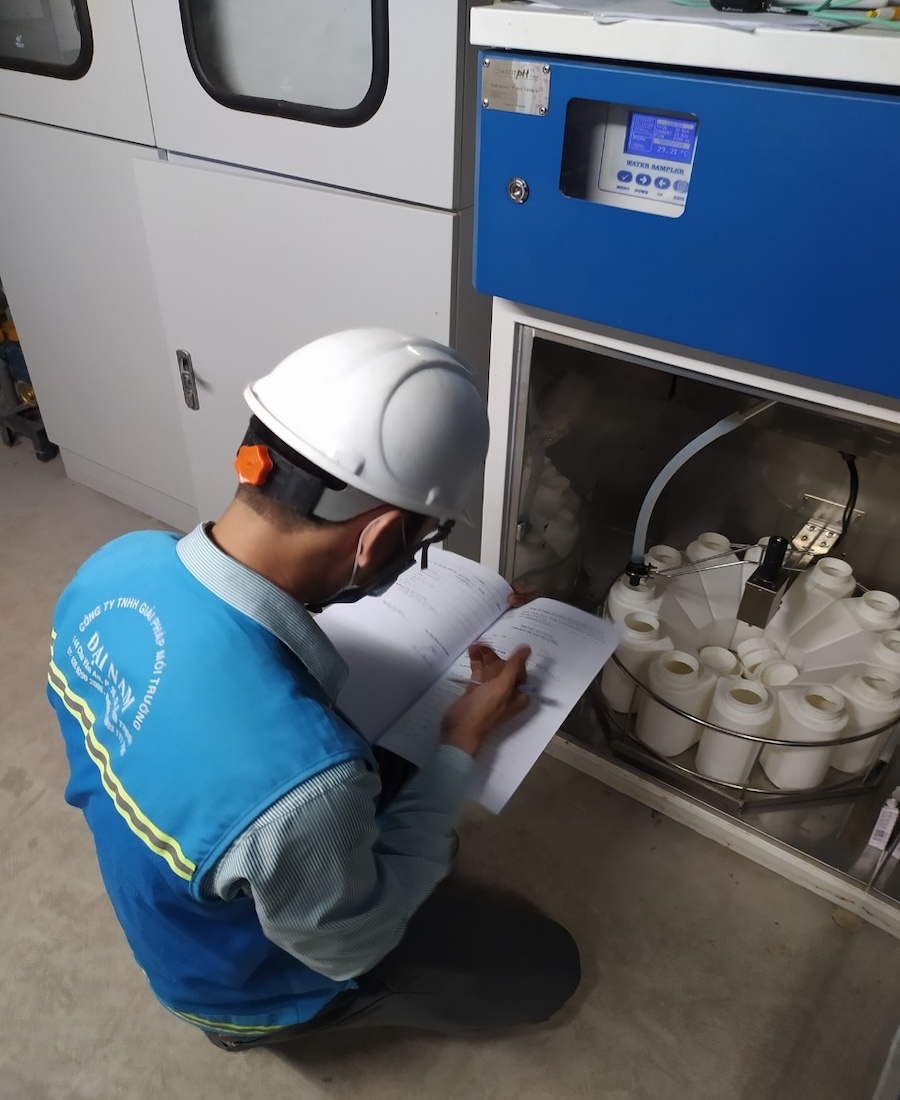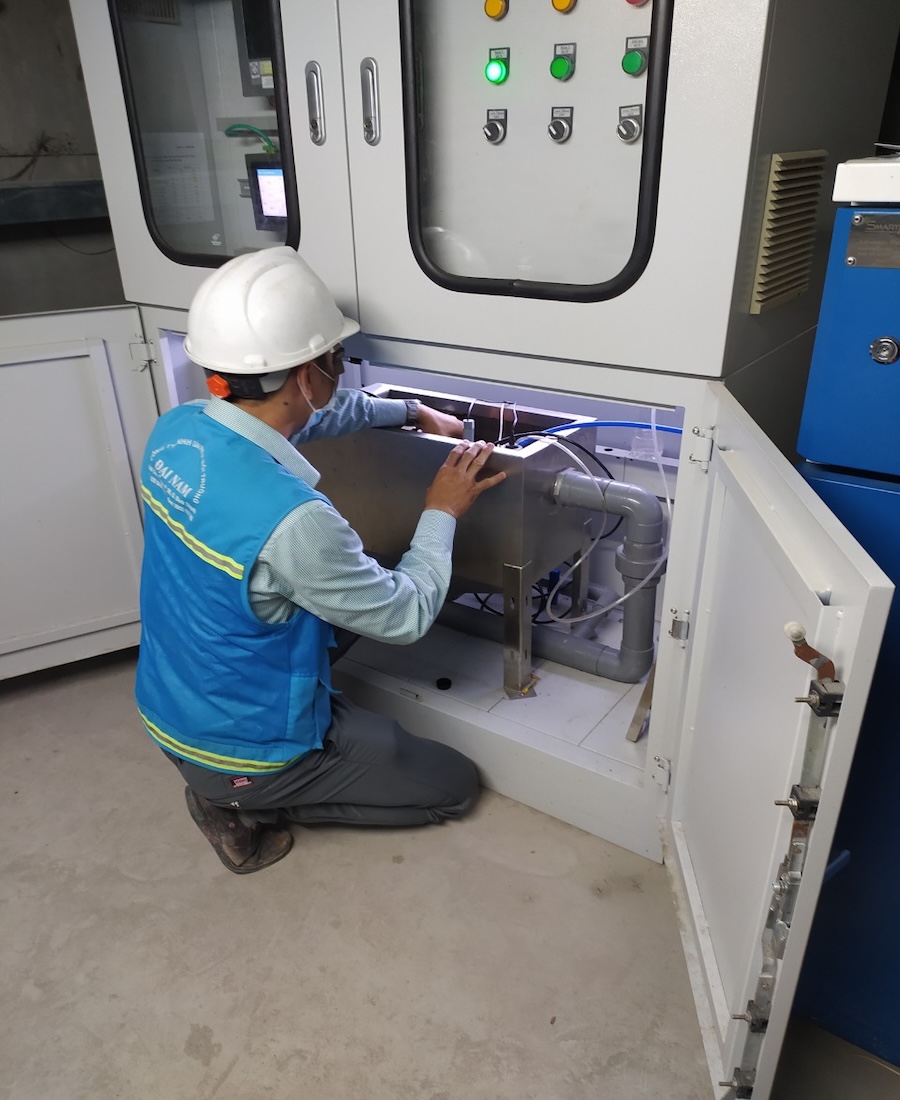Automatic wastewater monitoring systems are essential tools for real-time, continuous assessment of water quality. In the face of increasing environmental pollution, especially water contamination, these systems help businesses meet regulatory requirements and enhance water resource management.
According to Circular No. 10/2021/TT-BTNMT issued by the Ministry of Natural Resources and Environment, effective from June 18, 2021, automatic wastewater monitoring is mandatory for wastewater treatment plants with a capacity exceeding 1,000 m³/day. This circular replaces the previous Circular No. 24/2017/TT-BTNMT.
1. What Is Automatic Wastewater Monitoring?
Automatic wastewater monitoring involves using advanced equipment and technology to measure and monitor various water quality parameters during discharge. This system tracks parameters such as pH, turbidity, pollutant concentrations, and discharge flow rates, ensuring that effluent quality complies with environmental standards.

The Wastewater Monitoring System Helps Control Flow and Measure Pollution Indicators
2. Why Install an Automatic Wastewater Monitoring System?
Installing an automatic wastewater monitoring station is essential for businesses today. This system allows investors and facility operators to manage and monitor their wastewater treatment processes continuously—without needing to be physically present on-site.
Automatic wastewater monitoring helps government agencies and environmental supervisors effectively oversee industrial discharge activities. Continuous monitoring ensures strict control over wastewater discharge by tracking both the quality and flow rate of the effluent.
The continuous operation of an automatic monitoring station enables timely detection of issues and provides accurate data to implement appropriate solutions during wastewater treatment.
Thanks to real-time monitoring data, businesses, factories, and production facilities can easily determine whether their treated wastewater meets environmental standards. Based on this data, they can adjust processes to comply with stringent wastewater regulations.
From a legal standpoint, installing an automatic wastewater monitoring system is mandatory under Circular No. 10/2021/TT-BTNMT, which replaces Circular No. 24/2017/TT-BTNMT. According to the new regulation, any wastewater treatment system with a capacity greater than 1,000 m³/day must be equipped with an automatic monitoring system that sends data directly to the provincial Department of Natural Resources and Environment. Even smaller projects in high-pollution industries may also be required to install such systems based on the guidance of provincial authorities.
In conclusion, environmental monitoring is a critical investment for modern businesses. Investing in an online wastewater monitoring system not only strengthens control over wastewater quantity and quality but also ensures compliance with environmental laws.
Moreover, since the monitoring data can be accessed online in real-time, it helps reduce manpower and operational costs, making it a cost-effective and smart solution for environmental management.
3. Key Parameters Monitored in Automatic Wastewater Systems
When operating a wastewater monitoring system, it’s crucial to understand the essential parameters that are continuously tracked to ensure environmental compliance and process efficiency.
Core Wastewater Monitoring Parameters Include:
Flow rate (inlet and outlet)
Temperature and pH of the wastewater
TSS (Total Suspended Solids)
COD (Chemical Oxygen Demand)
Ammonia (NH₃)
Total Nitrogen (TN) and Total Phosphorus (TP) – applied to specific systems with stricter monitoring needs
For Cooling Water Systems Using Chlorine-Based Disinfectants:
Only the following parameters are typically required:
Flow rate
Temperature
Chlorine concentration
Common Measurement Units and Ranges in Wastewater Monitoring Systems:
1. pH: 2–12
2. Dissolved Oxygen (DO): 0–25 mg/L
3. Total Suspended Solids (TSS): 0–30,000 mg/L
4. COD (Chemical Oxygen Demand): 0–10,000 mg/L
5. BOD (Biochemical Oxygen Demand): 0–200,000 mg/L
6. Color (Pt-Co Scale): 0–1,000 Pt-Co
7. Ammonia (NH₃): 0–1,000 mg/L
8. Ammonium (NH₄⁺): 0–1,000 mg/L
9. Nitrate & Nitrite: 0–100 mg/L
10. Total Nitrogen (TN): 0–200 mg/L
11. Total Phosphorus (TP): 0–50 mg/L
12. TOC (Total Organic Carbon): 0–20,000 mg/L
13. E.Coli & Coliforms
14. Turbidity: 0–100 NTU
15. Free Chlorine / Total Chlorine: 0–5 mg/L
16. Conductivity: 0–200 µS/cm
17. Salinity: 2–92 ppt
18. Total Dissolved Solids (TDS): 0–9,999 mg/L
19. Hardness: 0–1,000 mg/L
20. Alkalinity: 0–500 mg/L
21. Manganese (Mn): 0.005–15 mg/L
22. Iron (Fe): 0.005–5 mg/L
23. Aluminum (Al): 0.005–2 mg/L
24. Oil-in-Water
25. Heavy Metals: Including Copper (Cu), Chromium (Cr), Cyanide (CN), Iron (Fe), Lead (Pb), Arsenic (As), Nickel (Ni), Zinc (Zn)
26. Open Channel Flow Measurement
4. Features of Automatic Wastewater Monitoring Systems
Our advanced wastewater monitoring system offers the following features:
Real-time, Continuous Multi-parameter Monitoring: Automatically measures multiple parameters simultaneously for comprehensive water quality assessment.
Automated Data Storage: All monitoring data is saved automatically for easy tracking and reporting.
User-friendly Control Interface: Simple and intuitive controls for seamless operation.
Modular Design for Easy Integration and Expansion: The system's modular architecture allows for quick integration and future scalability.
Automatic Alerts for Threshold Exceedance: Instant notifications when any parameter exceeds the preset threshold.
Automatic Sample Collection and Preservation: The system collects and preserves samples when abnormal readings are detected, ensuring data accuracy.
Remote Monitoring and Control Capability: Easily connect and control the system remotely via dedicated software and a reliable data transmission system.
On-site PC Connectivity: Seamless connection with local control room computers for real-time data storage and analysis.
Wireless Data Transmission: Transmits data to central monitoring stations using GSM/GPRS wireless technology and shares data over LAN and the internet for convenient access.
5. Implementation Process for Automatic Wastewater Monitoring Systems
This process ensures that wastewater monitoring is carried out precisely, efficiently, and without interruption:
Installation of the Monitoring Station: An automatic wastewater quality monitoring station is installed at the outlet of the wastewater treatment system. This strategic location allows for accurate measurement of treated effluent parameters.
Integration with On-Site Computer Systems: Monitoring devices are connected to computers at the centralized wastewater treatment plant. This enables real-time data control, monitoring, and analysis.
Data Transmission via GSM/GPRS Network: Monitoring data is wirelessly transmitted to a centralized data collection and processing center through GSM/GPRS technology. This allows for remote access, monitoring, and analysis of wastewater data.
Construction of Open Channels and Station House: Open channels and monitoring houses are established to facilitate the proper installation of measurement devices and ensure reliable water sampling.
Automated Sampling System: A fully automated sampling system collects wastewater samples at predetermined intervals. This ensures continuous and objective water quality assessment.
Installation of Surveillance Systems: To enhance operational safety, the monitoring station is equipped with surveillance cameras, smoke detectors, and fire alarms. These features help detect incidents promptly and protect monitoring equipment.
6. Why Choose Đại Nam Environmental Solutions?
Dai Nam Environmental Solutions Co., Ltd. proudly stands as a leading provider in the field of wastewater treatment, specializing in the design, construction, and installation of environmental monitoring stations, including both surface water monitoring and wastewater monitoring systems.
Our company has successfully implemented the installation and operation of automated wastewater and surface water monitoring stations in collaboration with Hach, a global leader in automatic monitoring equipment and water quality analysis chemicals. Hach also provides corresponding laboratory instruments for validating continuously monitored parameters.
Our monitoring systems feature fully synchronized technologies between online and laboratory equipment, ensuring consistency and reliability. Hach's analytical methods are aligned with recognized standards, including Vietnamese National Standards (TCVN), AOAC (Association of Official Analytical Chemists), SMEWW (Standard Methods for the Examination of Water and Wastewater), and USEPA (United States Environmental Protection Agency). This compatibility allows engineers at treatment plants to easily verify real-time monitoring data and maintain compliance with regulatory requirements.

The Automatic Monitoring System Designed, Installed, and Built by Dai Nam
Dai Nam Environmental Solutions proudly provides advanced automatic wastewater monitoring systems with the following outstanding features:
Display & Control Unit
Multi-device Connectivity: The controller can connect up to 8 sensors and analytical devices simultaneously.
Modular Design: Separated sensor and display modules allow flexible system configuration, enabling one display to manage multiple sensor modules as needed.
High-Level Control Interface: User-friendly touchscreen for intuitive operation.
Multiple Communication Protocols Supported: Compatible with mA, Profibus, Modbus, and more for seamless system integration.
TOC and COD Analyzer
Dual-Parameter Measurement: One device measures both Total Organic Carbon (TOC) and Chemical Oxygen Demand (COD).
Advanced Infrared Technology: Utilizes two-stage oxidation and CO₂ infrared detection for unmatched accuracy, far superior to traditional UV sensors (which typically offer >15% deviation).
Self-Calibrating and Self-Cleaning: Reduces maintenance time while ensuring long-term accuracy and continuous operation.
Supports Standard Protocols: mA, Profibus, Modbus, and more.
pH and Temperature Sensors
Integrated Temperature Compensation: Ensures high accuracy in all conditions.
Chemical-Resistant Materials: Made with durable PEEK and Ryton (PVDF) for long-lasting use in harsh environments.
Replaceable Salt Bridge Electrode Design: Minimizes maintenance time.
Easy Calibration: Compatible with standard buffer solutions for reliable calibration.
Digital Dissolved Oxygen (DO) Sensor
Optical DO Technology (Membrane-Free): No membrane required, reducing maintenance and increasing sensor life.
Ion Interference Resistant: Not affected by dissolved ions such as heavy metals or sulfides.
Fast Response Time: Approx. 30 seconds compared to 90 seconds for conventional electrochemical methods.
Low Calibration Frequency: Requires calibration only once or twice a year, compared to monthly with traditional sensors.
No Replacement Solutions Needed: Minimizes operational costs and maintenance time.
Digital TSS (Total Suspended Solids) Sensor
Optical IR Scattering Method: Infrared-based scattering technology meets European standards, unaffected by water color.
Wide Measurement Range: Capable of measuring turbidity from 1 to 4000 NTU.
Built-in Self-Cleaning Wiper: No extra accessories needed, enhancing operational efficiency.
Quick Response Time and durable stainless steel (1.4571 / 316Ti) construction for superior chemical resistance.
Ammonia (NH₄⁺) Sensor
Accurate Detection: Uses electrochemical or optical technology for precise ammonia measurement under harsh environmental conditions.
Automatic Cleaning System: Integrated wiper or pressure cleaning mechanism reduces manual maintenance.
Fast Response Time: Quickly reacts to changes in ammonia concentration, enabling immediate response to abnormalities.
We hope this overview has provided valuable insights into our wastewater monitoring system.
For more information or to discuss your project needs, please contact our HOTLINE: 0909 738 796
or EMAIL us at info@dainam-enviro.com for partnership and consultation.

